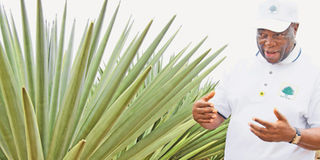Katani MD: Let farmers play key role in 2025 drive

Katani Limited Managing Director Salum Shamte at a sisal plantation run by the firm. PHOTO|CORRESPONDENT
What you need to know:
- In this interview with George Sembony, he shares his views regarding the industrialisation agenda. Read on:
Salum Shamte is not a new name in Tanzania’s private sector. A long-standing expert in Tanzania’s agricultural sector and the managing director of Katani Ltd, Mr Shamte has held several positions in various public and private entities.
In this interview with George Sembony, he shares his views regarding the industrialisation agenda. Read on:
Question: Is the government’s commitment to turn Tanzania into to a middle income industrialized economy by 2025 feasible?
Yes, it is feasible if we stick to a practicable approach. Industrialisation is crucial and unavoidable if we really want to reach the goal of becoming a middle income economy by the set date.
What can the farmers hope from the new development?
Industrialization must be seen on basis of value chain development. Priority should be attached to development of industries that add value to agricultural goods. We need now, more than ever, to develop practical strategies to develop and improve agricultural production. Farmers must be partners in this endeavour. The farmer must be a shareholder, owning the whole process.
Is this practicable in the Tanzanian situation?
It seemed impracticable then but it is now a reality. We have managed to turn the farmer into a partner in the value chain by giving him shares at the processing level. This has moved the poor farmer, some of them formers sisal workers, into a middle level farmer who earns at least Sh1 million per month. They now live a better life, including joining social security schemes.
How many farmers do you have in the smallholder sisal farming scheme?
There are a total of 2,300 smallholder sisal farmers with a total of 50,000 acres involved in the system. Their contribution to the total sisal fibre production critical in reviving sisal as the ‘white gold’ it was in the 1960s to 1970s.
Do you see any hopes for increased zeal in sisal production by smallholder farmers?
Yes. The demand for sisal is going up, far outstripping production and the price has continued to rise for the last ten years. The demand for sisal fibre in the internal market is also due to a greater demand in the international market. This means for the need increase production due to good prices. Definitely, the zeal to enter the fray of the sisal farming is increasing. More people now want to try sisal farming.
Why has the demand continued to rise?
New consumer demands for natural fibres are expanding the markets for sisal in more high-value applications. A dramatic rise in the use of sisal in the construction industry is increasing the demand. It is used for reinforcing composites or enhance fibre-glass used to reinforce plastic in automobiles, boats, furniture, water tanks and pipes. Sisal is also used to add strength in cement mixtures for the development of low cost housing and to replace asbestos in roofing and brake-pads. In addition, it is an insulation material and can be made into fibre-board as a wood substitute. Given its porosity, it can be used in cigarette paper filters and things like tea bags. It is also used in the Textile industry, specifically fibre being used in buffing cloth. Sisal is strong enough to polish steel and soft enough not to scratch it and that is why there is a great demand in China.
We have proved that sisal waste products - can be used for making biogas, pharmaceutical ingredients and building material. The biomass left after extraction of fibres is almost 98 percent of the plant. The Common Fund for Commodities, UNIDO and the Tanzanian sisal industry funded the first commercial plant using sisal residues to produce electricity. We boast of having the first plant that produces electricity from sisal waste at Hale.
Evaluation of the plant indicates that 75 per cent of the energy produced could be distributed to rural homes and 25 per cent used in sisal processing. The juice of the plant is used to make pharmaceuticals like hecogenin, inulin and others.
What is the major challenge facing agriculture in general?
Financing agriculture is a major problem for a number of years. It is obvious we cannot improve agriculture nor attain the industrialization goal without proper financing channels. An agricultural Bank has been established. There is an agricultural window in the Tanzania Investment Bank. We need to strengthen those facilities. Financial support is needed to move the industrialization process ahead.




